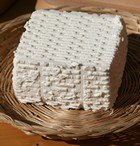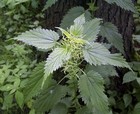How to Make Natural Rennet from Animals and Plants
The History of Rennet
It is said that rennet was discovered thousands of years ago when
people used stomachs of animals to carry milk in. As they traveled from
place to place it soon became apparent the milk that they were carrying
had started to turn to cheese.
We now know that the stomach of animals contains mainly chymosin which is responsible for the coagulation of milk.
Since our understanding of how milk becomes cheese has improved we also know that is is not just animals that can contribute towards this process, but we can also make cheese using plant based rennets.
We now know that the stomach of animals contains mainly chymosin which is responsible for the coagulation of milk.
Since our understanding of how milk becomes cheese has improved we also know that is is not just animals that can contribute towards this process, but we can also make cheese using plant based rennets.
How to Make your Own Animal Rennet
In general, it is the stomach of the calf that is preferred as it makes a more superior cheese, especially hard cheeses, and there are a number of different ways in which one can go about preparing the stomach to cure and preserve it for your cheese making.
Any of the animals mentioned above should be slaughtered at not more than 2 days old. If you have lost lambs soon after birth, and you are a cheesemaker, then these stomachs would be ideal to use. The stomach of a newly killed animal will contain traces of curd and these should be washed and removed, otherwise if not, your cheese will end up tasting very strong and unpleasant.
Once the animal has been killed you will now need to prepare the stomach, by first washing it, as advised, followed by salting it. Now there are a number of different methods of doing this, you will have to decide which method is best for you.
There are those who do nothing more with the stomach other than to salt it liberally with handfuls of salt on both sides pressing the salt into the flesh with a rolling pin, rolling it up and then hanging it in warm, dry place.
Others leave the stomach to bathe in a strong brine bath for a few days and then hang it up to dry. There are others who will take several washed stomachs, salt and layer them, and leave them in this dry salted state until the following cheese making season.
Those stomachs that have been preserved in a brine bath for rennet making are removed, drained and spread out on a flat surface before being salted again, front and back, rolled up and then hang up to dry in a warm dry place until needed.
There are also those who take the stomach and prepare it in the same way, but use it differently. Here the calf stomach is cut into 1/2 inch squares and then packed away in a large jar packed with salt. Before using the rennet the pieces you will want to use will be soaked in water for 1/2 hour and then washed well. The rennet is then tied together with a piece of string before being immersed into the milk to get it to coagulate.
Yet another method, is again to use the calf stomach but this time to salt it and then cut it up into strips and dry it as you would jerky. Then once it has dried out, cut these strips into 1 inch square pieces. Add it to your milk to start the process. Each square is equal to 2 drops of liquid rennet.
Whatever method you choose for preparing your homemade rennet, the salted stomach has to be left to cure for at least 12 months before it can be used. Only then will it produce a strong rennet good enough to cause your milk to coagulate and produce good cheese.
Never be tempted to use the rennet before hand as you will be very sorry with the results as your cheese will be full of holes, and can even make the cheese blow out.
The Process of Making and Using Homemade Animal Rennet
Take the entire stomach that has now been dried over the last year, and
pour 1-3 quarts of water for each stomach and leave it in
this water for 2-3 days. Then skim and strain this liquid. What you now
have is liquid rennet which is ready for immediate use.
As there are different ways in curing the stomach, there are also different ways in which you can make the liquid rennet, although the above method is the most common.
The method where many stomachs were used in layering, these can be prepared in the same way. Pour 2 quarts of water over each stomach, let is stand no more than 2 days in this water, and then remove the liquid and use.
As there are different ways in curing the stomach, there are also different ways in which you can make the liquid rennet, although the above method is the most common.
The method where many stomachs were used in layering, these can be prepared in the same way. Pour 2 quarts of water over each stomach, let is stand no more than 2 days in this water, and then remove the liquid and use.
Water used in Making Rennet
Only ever used pure water, and never from the tap. There are some who
use a clear whey instead of using water, which is also fine. If you
want to get creative you can also add aromatic herbs and even lemons to
the mix.
How to use your Homemade Rennet
You will be able to use your liquid rennet by pouring it into milk that
has been warmed to 90 - 95 degrees F. and depending on the
quantity of your milk, you will use either a Tablespoon to 1/2 pint if
you are using 30 - 40 gallons of milk.
Never add more rennet than necessary. Too much rennet results in tough curds, and the possibilty of your cheese blowing out when it is set aside to dry. It can also affect the taste of the cheese.
Adding too little liquid rennet will cause a delay in your cheese making process and the butter fats separating from the curd.
If conditions are right your milk should start coagulating after 15 minutes. However you may even have to wait longer, up to 90 minutes if the quality of your rennet is not as strong as you think it is.
Make sure that the curd is broken as soon as the milk has become fully coagulated. If you allow the milk to stand longer than necessary before breaking the curd your cheese will end up hard and tough.
Never add more rennet than necessary. Too much rennet results in tough curds, and the possibilty of your cheese blowing out when it is set aside to dry. It can also affect the taste of the cheese.
Adding too little liquid rennet will cause a delay in your cheese making process and the butter fats separating from the curd.
If conditions are right your milk should start coagulating after 15 minutes. However you may even have to wait longer, up to 90 minutes if the quality of your rennet is not as strong as you think it is.
Make sure that the curd is broken as soon as the milk has become fully coagulated. If you allow the milk to stand longer than necessary before breaking the curd your cheese will end up hard and tough.
Making Rennet from Whey
You can use whey from a previous
batch of cheese as a rennet. Reserve 1 quart of whey and use this as
rennet for coagulating your milk. You can use 1/4 cup of the whey to
work on 5 gallons of milk.
Replace the 1/4 cup each day from the next batch of whey. If you make cheese every day, you can continue to use the whey for rennet every day for 14 days. After that the potency of the whey will start to fall off, and you would be better to start again with a fresh batch.
Replace the 1/4 cup each day from the next batch of whey. If you make cheese every day, you can continue to use the whey for rennet every day for 14 days. After that the potency of the whey will start to fall off, and you would be better to start again with a fresh batch.
Making Vegetarian Rennet from Plants
If you wish to make a vegetarian rennet you can do so using the
following plants:
- nettle leaves
- butterwort leaves
- mallow
- yarrow
- teasel
- knapweed
- lady's bedstraw
- thistles
- fig tree bark
There are 2 ways of using the plants. One of the simplest ways is to
take enough plant matter and crush the plants in a large pestle and
mortar until you get enough of the juice from the plant which then will
allow you to coagulate the milk.
Another way is to use the leaves dry. If you are making rennet from nettles, once you have harvested the leaves chop them finely and leave them to dry. Then make 6 cups of very strong nettle tea and mix with 4 cups of uniodizen salt. There is no specific amount for each quart of milk used but add just enough to get the coagulation that you need.
You will have to experiment and add 1 tablespoon every 15 minutes to judge. Just remember to keep your milk at the required temperature, while you wait.
The only drawback of using vegetarian rennets for hard cheese that need to be aged for a long time, they tend to develop a slightly bitter taste.
Another way is to use the leaves dry. If you are making rennet from nettles, once you have harvested the leaves chop them finely and leave them to dry. Then make 6 cups of very strong nettle tea and mix with 4 cups of uniodizen salt. There is no specific amount for each quart of milk used but add just enough to get the coagulation that you need.
You will have to experiment and add 1 tablespoon every 15 minutes to judge. Just remember to keep your milk at the required temperature, while you wait.
The only drawback of using vegetarian rennets for hard cheese that need to be aged for a long time, they tend to develop a slightly bitter taste.
Final Tips:
Whatever rennet you use, if you store it in a fridge, your rennet will
last 3 months. Some say up to a year, however, 3 months on the safe
side as the older the rennet, the more bitter your cheese will be.
Don't expose your liquid rennet to light as the light will cause it to break down.
Remember to bring your rennet that has been in the fridge back up to room temperature before you use it, as temperatures below 50 degrees F. will cause the activity of the rennet to be supressed.
If you are using a recipe that is using rennet in tablet form, you can substitute
1/4 teaspoon normal strength liquid rennet for half a rennet tablet.
Don't expose your liquid rennet to light as the light will cause it to break down.
Remember to bring your rennet that has been in the fridge back up to room temperature before you use it, as temperatures below 50 degrees F. will cause the activity of the rennet to be supressed.
If you are using a recipe that is using rennet in tablet form, you can substitute
1/4 teaspoon normal strength liquid rennet for half a rennet tablet.






New! Comments
Do you have something of value to add? Leave me a comment in the box below.